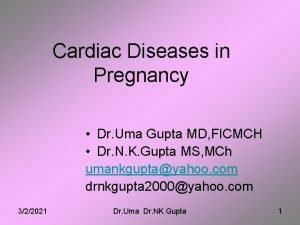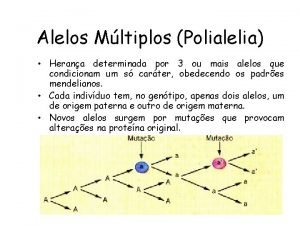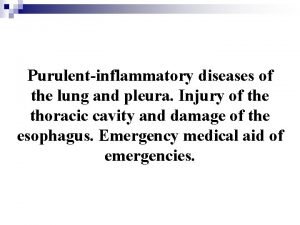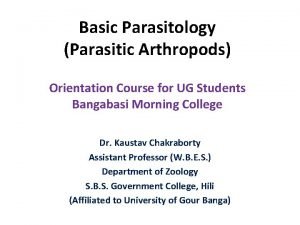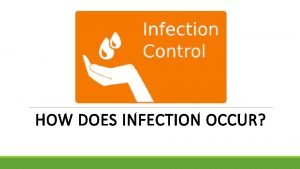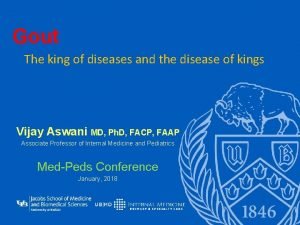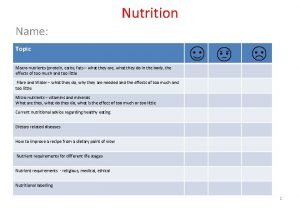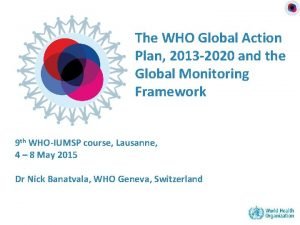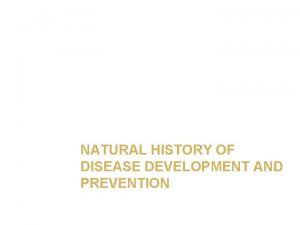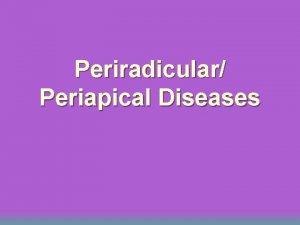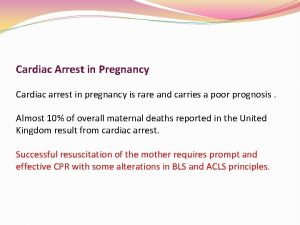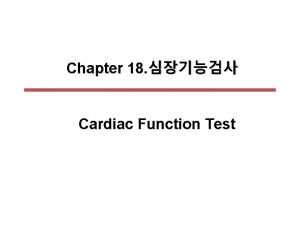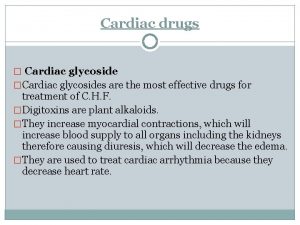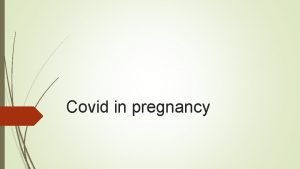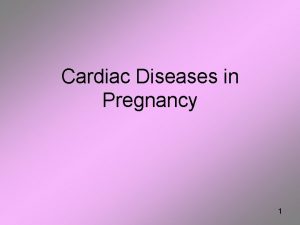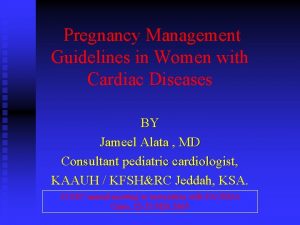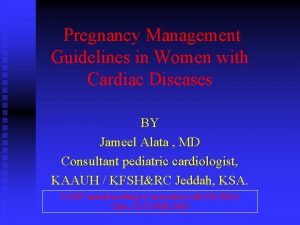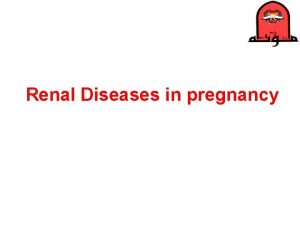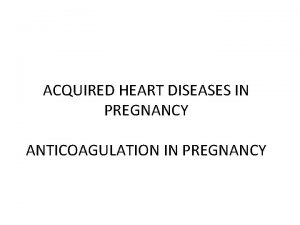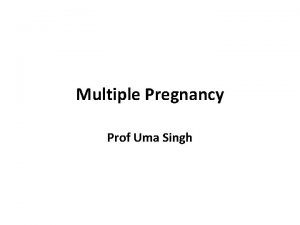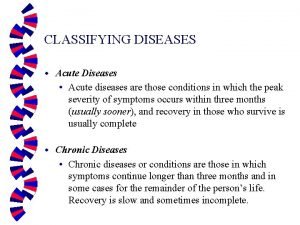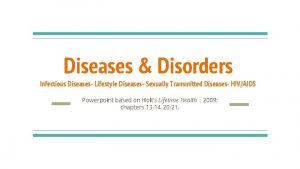Cardiac Diseases in Pregnancy Dr Uma Gupta MD


















































- Slides: 50

Cardiac Diseases in Pregnancy • Dr. Uma Gupta MD, FICMCH • Dr. N. K. Gupta MS, MCh umankgupta@yahoo. com drnkgupta 2000@yahoo. com 3/2/2021 Dr. Uma Dr. NK Gupta 1

The incidence and changing pattern of heart disease • It ranges from 0. 1% to 4%. • Hospital statistics - industrialized countries have shown a decrease in the incidence from 0. 9% to 0. 3% 3/2/2021 Dr. Uma Dr. NK Gupta 2

Incidence of heart disease……… Sharp decline in the incidence of chronic rheumatic heart disorders. Advances in the medical and surgical treatment of patients with congenital heart defects has resulted in an increased survival to reproductive age. 3/2/2021 Dr. Uma Dr. NK Gupta 3

Maternal mortality from heart disease • Statistics have demonstrated a decline in maternal mortality from cardiac disease since 1950 from 5. 6 to 0. 3 per 100 000 births. • B’s of improved medical care of the pregnant cardiac patient and a sharp decrease in the incidence of rheumatic heart disease. 3/2/2021 Dr. Uma Dr. NK Gupta 4

Maternal mortality from heart disease • Confidential enquiry of latest report on maternal deaths in the United Kingdom, has shown that cardiac disease accounted for the greatest number of maternal deaths • accounting for 35 (16. 5%) of all maternal deaths over the period 1997– 99* • (37 of 323) in the 1991 to 1993 triennium • (18) -1988 to 1990 trienniums • (23) -1985 to 1987 * de Swiet M. Cardiac disease. In: Lewis G, Drife J, eds. Why Mothers Die 1997– 1999. The Confidential Enquiries into Maternal Deaths in the United Kingdom. London: Royal College of Obstetricians and Gynaecologists, 2001; 153– 64 3/2/2021 Dr. Uma Dr. NK Gupta 5

Maternal mortality from heart disease Cardiac diseases is also the leading cause of indirect maternal death. Of the cardiac deaths reported to the Confidential enquiry between 20002002, 40% were noted to have substandard care. Deans CL, Uebing A, Steer PJ. Cardiac disease in pregnancy. In Progress in Obstetrics and Gynaecology, Vol 17, Edi Studd J, Tan S L, Chervenak FA. Churchill Livingstone 2007, 164 -182. 3/2/2021 Dr. Uma Dr. NK Gupta 6

Cardiovascular Physiology of Pregnancy • Normal pregnancy is associated with an increase of 30 to 50 percent in blood volume • Blood volume increases, starting at the sixth week and rising rapidly until mid pregnancy; the levels peak by 20 to 24 weeks of pregnancy and then are either sustained until term or decrease An estrogen-mediated stimulation of the reninangiotensin system results in sodium and water retention appears to be the mechanism underlying the blood volume increase. 3/2/2021 Dr. Uma Dr. NK Gupta 7

Cardiovascular Physiology of Pregnancy • Increase in cardiac output is most significant change during pregnancy. • It begins to rise in first trimester and steadily rises to peak at 32 weeks by 30 to 50%. • Cardiac output is normally 4. 2 L/min. , is 6. 5 L/min. at 8 -10 weeks of pregnancy and remains so till near term. • Increase in cardiac output is achieved by rise in stroke volume (in early pregnancy) and Heart Rate (in latter part of pregnancy) adjusting together 3/2/2021 Dr. Uma Dr. NK Gupta 8

Cardiovascular Physiology of Pregnancy • Due to rise in endogenous circulating catecholamine, there is positive inotropic and chronotropic myocardial response. • Later in pregnancy, the rise is related to an acceleration of heart rate (25%), since stroke volume decreases as a result of vena caval compression. 3/2/2021 Dr. Uma Dr. NK Gupta 9

3/2/2021 Dr. Uma Dr. NK Gupta 10

• Blood Pressure remains almost to prepregnant levels except a tendency to fall during pregnancy (particularly during midtrimester) as the systemic vascular/peripheral resistance falls (due to large arteriovenous shunts at placental bed and physiologic vasodilation secondary to endothelial prostacyclin and circulating progesterone) 3/2/2021 Dr. Uma Dr. NK Gupta 11

• Colloid oncotic pressure is another important variable • Both plasma and interstitial colloid oncotic pressure decrease throughout pregnancy • There is accompanying increase in capillary hydrostatic pressure. • An increase in hydrostatic pressure or a decrease in colloid oncotic pressure may overcome the delicate balance that favors oedema formation 3/2/2021 Dr. Uma Dr. NK Gupta 12

Colloid oncotic pressure • After delivery, decrease in plasma colloid oncotic pressure takes place reaching a peak between 6 to 16 hours and returns towards intrapartum level after 24 hours. • These changes can lead to dependant oedema complicating diagnosis of cardiac decompensation. 3/2/2021 Dr. Uma Dr. NK Gupta 13

Simulating cardiac disease Owing to these normal changes, many healthy pregnant women have symptoms mimicking those of cardiac disease, Including: fatigue, dyspnea, and light-headedness, & number of “abnormal” findings on physical examination, electrocardiography, and echocardiography 3/2/2021 Dr. Uma Dr. NK Gupta 14

3/2/2021 Table 1. Normal physiological changes of pregnancy that mimic symptoms and signs of cardiac disease Symptoms Tiredness Dyspnoea Orthopnoea Syncope Light-headedness Physical signs Peripheral oedema Hyperventilation Distended neck veins with prominent A and V waves Brisk, diffuse, and displaced left ventricular impulse Palpable right ventricular impulse Increased S 1 intensity Persistent splitting of S 2 Early ejection systolic murmurs at lower left sternal edge or pulmonary area Cervical venous Dr. Uma hum Dr. NK Gupta 15 Mammary souffle

Contd. . Table 1. Normal physiological changes of pregnancy that mimic symptoms and signs of cardiac disease 3/2/2021 Electrocardiogram Left axis deviation ST segment and T wave changes Small Q, inverted P or T wave in lead III Increased R wave amplitude in lead V 2 Atrial or ventricular ectopics Chest X-ray Straightened left upper cardiac border Horizontal heart position Increased lung markings Echocardiogram Increased left/right ventricular dimensions Mild increase in left/right atrial size Slightly improved left ventricular systolic function Functional tricuspid/pulmonary insufficiency Small pericardial Dr. Uma effusion Dr. NK Gupta 16

Management areas Areas be considered in the clinical approach to the woman with heart disease who is pregnant or considering pregnancy: 1) Risk stratification, Pre-conceptional 2) Antepartum management, 3) Peripartum management, 4) Recurrence of congenital lesion in the neonate, 5) Site of antepartum and peripartum care. 3/2/2021 Dr. Uma Dr. NK Gupta 17

Pre-conceptional counselling • This is an important aspect of management or the cardiac patient planning a pregnancy. • Ideally, the obstetrician and cardiologist should work together to help the patient make an informed decision. • Prevent an unwanted pregnancy and avoid the risks associated with pregnancy continuation or termination. 3/2/2021 Dr. Uma Dr. NK Gupta 18

Risk assessment • Poor functional status (NYHA class III or IV) or cyanosis • Left ventricular systolic dysfunction (ejection fraction < 0. 40) • Left heart obstruction (mitral valve area <2. 0 cm 2, aortic valve area < 1. 5 cm 2, or peak left ventricular outflow tract gradient > 30 mm Hg) 3/2/2021 Dr. Uma Dr. NK Gupta 19

Risk assessment A cardiac event (arrhythmia, stroke, transient ischemic attack, or pulmonary edema) before pregnancy but since a prior cardiac surgical procedure. 3/2/2021 Dr. Uma Dr. NK Gupta 20

Risk assessment Siu developed a risk index incorporating these factors. In a woman with heart disease and no other risk factors, the likelihood of a cardiac event during pregnancy is about 5%, increasing to 25% with one risk factor & 75% with more than one risk factor. Siu SC, Sermer M, Colman JM, et al. Prospective multicenter study of pregnancy outcomes in women with heart disease. Circulation 2001; 104: 515– 521. 3/2/2021 Dr. Uma Dr. NK Gupta 21

Table 2. Maternal mortality risk and cardiac disease Group Cardiac disease Associated mortality risk I Atrial septal defect* <1% Ventricular septal defect* Patent ductus arteriosus* Pulmonary/tricuspid valve disease Corrected tetralogy of Fallot Bioprosthetic valve Mitral stenosis, NYHA Class I, II II Coarctation of aorta without valvular involvement 5% - 15% Uncorrected tetralogy of Fallot Marfan’s syndrome with normal aorta Mechanical prosthetic valve Mitral stenosis with atrial fibrillation or NYHA Class III, IV Aortic stenosis Previous myocardial infarction III Pulmonary hypertension—primary or secondary 25% - 50% Coarctation of aorta with valvular involvement Marfan’s syndrome with aortic involvement Peripartum cardiomyopathy *Uncomplicated 3/2/2021 Dr. Uma Dr. NK Gupta 22

• A careful history is obtained to identify previous cardiac complications. • The patients functional status as per The New York Heart Association(NYHA) is defined 3/2/2021 Dr. Uma Dr. NK Gupta 23

Table 3. NEW YORK HEART ASSOCIATION FUNCTIONAL CLASSIFICATION OF CARDIAC DISEASE CLASS I No functional limitation of activity. No symptoms of cardiac decompensation with activity. CLASS II Mild amount of functional limitation. Patients are asymptomatic at rest. Ordinary physical activity results in symptoms. CLASS III Limitation of most physical activity. Asymptomatic at rest Minimal physical activity results in symptoms. CLASS IV Severe limitation of physical activity results in symptoms. Patients may be symptomatic at rest/heart failure at any point of pregnancy. CLASS V If patient is on ionotropic support, ventilator, Assisted circulation or having comprised renal or pulmonary function necessitating dialysis/EMCO to maintain vital signs. The criteria committee of the New York Heart Association, Nomenclature and criteria for diagnosis of diseases of heart and great vessels, Edi 8, New York Association, 1979. 3/2/2021 Dr. Uma Dr. NK Gupta 24

Antepartum Care • The chief aim of management of the patient in pregnancy is to keep patient within her cardiac reserve. • It is preferable to have detailed baseline information prior of pregnancy. 3/2/2021 Dr. Uma Dr. NK Gupta 25

Antepartum care • Limiting activity is helpful in severely affected women with ventricular dysfunction, • left heart obstruction, or class III or IV symptoms. • Hospital admission by mid-second trimester may be advisable for some. 3/2/2021 Dr. Uma Dr. NK Gupta 26

Antepartum care • Problems should be identified early and treated aggressively, especially pregnancy induced hypertension, hyperthyroidism, infection, and anemia. 3/2/2021 Dr. Uma Dr. NK Gupta 27

Table 4. Recommended antibiotic prophylaxis for high-risk women undergoing genitourinary or gastrointestinal procedures Category Drug and dosage High-risk patient Ampicillin, 2 g IM or IV, plus gentamicin sulfate (Garamycin), 1. 5 mg/kg IV 30 min before procedure; ampicillin, 1 g IV, or amoxicillin (Amoxil, Trimox, Wymox), 1 g PO 6 hr after procedure High-risk patient Vancomycin HCl (Vancocin, Vancoled), 1 g IV over 2 hr, who has penicillin plus allergy gentamicin sulfate, 1. 5 mg/kg IV 30 min before procedure 3/2/2021 Dr. Uma Dr. NK Gupta 28

3/2/2021 Dr. Uma Dr. NK Gupta 29

Antepartum care Beta-blockers rather than digoxin should be used to control the heart rate for patients with functionally significant mitral stenosis. Empiric therapy with beta-blockers is offered to patients with coarctation, Marfan syndrome, and ascending aortopathy for other reasons (eg, a bicuspid aortic valve). 3/2/2021 Dr. Uma Dr. NK Gupta 30

Arrhythmias should be treated if warranted Premature atrial or ventricular beats are common in normal pregnancy, and in patients with preexisting arrhythmias, Pregnancy may exacerbate their frequency and hemodynamic severity. These usually are not treated. 3/2/2021 Dr. Uma Dr. NK Gupta 31

Antepartum care Sustained tachyarrhythmias, such as atrial flutter or atrial fibrillation, should be treated promptly. If possible, all antiarrhythmic drugs should be avoided during the first trimester, and those known to be teratogenic should be avoided throughout pregnancy. Because of their safety profiles, preferred drugs include digoxin, beta-blockers and adenosine. 3/2/2021 Dr. Uma Dr. NK Gupta 32

3/2/2021 Dr. Uma Dr. NK Gupta 33

Antepartum care • Anticoagulation therapy. No current strategy is equally safe for both mother and fetus. 3/2/2021 Dr. Uma Dr. NK Gupta 34

Anticoagulation therapy Oral therapy with warfarin is effective and logistically easy. However, it can affect embryonic organ development, although some evidence shows that a dosage of 5 mg per day may not be teratogenic. Fetal intracranial bleeding is a risk throughout pregnancy, particularly during vaginal delivery, unless warfarin is stopped before labor. 3/2/2021 Dr. Uma Dr. NK Gupta 35

Anticoagulation therapy * Heparin in adjusted subcutaneous doses does not cross the placenta and so has no teratogenic effects. However, it may cause maternal thrombocytopenia and osteoporosis and is less effective in preventing thrombosis in patients with prosthetic valves. 3/2/2021 Dr. Uma Dr. NK Gupta 36

Anticoagulation therapy More recent guidelines recommend either (1) adjusted-dose heparin during the entire pregnancy or (2) adjusted-dose heparin until the 13 th week of gestation, warfarin from the 14 th week to the middle of the third trimester, and then restart adjusted-dose heparin. * Low-molecular-weight heparin in adjusted doses is easier to administer and has been suggested as an alternative to adjusted-dose unfractionated heparin. Bates SM, Greer IA, Hirsh J, Ginsberg JS. Use of antithrombotic agents during pregnancy. Chest 2004; 126: 627 S– . 644 S 3/2/2021 Dr. Uma Dr. NK Gupta 37

Anticoagulation therapy At week 36 # *Discontinue warfarin *Change to UFH titrated to a therapeutic a. PTT or antifactor Xa level. At Delivery: *Restart heparin therapy 4 to 6 hr after delivery if no contraindications *Resume warfarin therapy the night after delivery if no bleeding complications #if labor begins while the woman is receiving warfarin, anticoagulation should be reversed and caesarean delivery performed Ginsberg JS, Greer I, Hirsh J. Use of antithrombotic agents during pregnancy. Chest 2001; 119: Suppl: 122 S-131 S 3/2/2021 Dr. Uma Dr. NK Gupta 38

Anticoagulation therapy Monitoring • With LMWH administered sc. twice daily maintain anti-Xa level between 0. 7 and 1. 2 U/ml 4 hours after admn. • With dose adjusted UFH, the a. PTT should be at least twice control. • those on warfarin, the INR goal should be 3. 0(range 2. 5 to 3. 5) Chan WS, Anand S, Ginsberg JS. Anticoagulation of pregnant women with mechanical heart valves: a systematic review of the literature. Arch Intern Med 2000; 160: 191 -196 3/2/2021 Dr. Uma Dr. NK Gupta 39

Peripartum management • Cesarean section is indicated only for the following conditions: • Aortic dissection • Marfan syndrome with dilated aortic root • Taking warfarin within 2 weeks of labor. 3/2/2021 Dr. Uma Dr. NK Gupta 40

Peripartum care Preterm induction is uncommon. However, once fetal lung maturity is assured, a planned induction and delivery may be warranted for high-risk patients to ensure that appropriate staff and equipment are available. 3/2/2021 Dr. Uma Dr. NK Gupta 41

Peripartum care Antibiotic prophylaxis for endocarditis is not routine. AHA guidelines do not recommend routine endocarditis prophylaxis for cesarean section delivery or for uncomplicated vaginal delivery without infection. 37 However, some centers do administer endocarditis prophylaxis for vaginal delivery in women with structural heart disease, as an uncomplicated delivery cannot always be anticipated. 3/2/2021 Dr. Uma Dr. NK Gupta 42

Peripartum care Positioning the patient on her left side lessens the hemodynamic fluctuations associated with contractions when the patient is supine. 3/2/2021 Dr. Uma Dr. NK Gupta 43

Peripartum care • Forceps or vacuum extraction should be considered at the end of the second stage of labor to shorten and ease delivery. 3/2/2021 Dr. Uma Dr. NK Gupta 44

Peripartum care • Postpartum monitoring Because hemodynamics do not return to baseline for many days after delivery, patients at intermediate or high risk may require monitoring for at least 72 hours postpartum. 3/2/2021 Dr. Uma Dr. NK Gupta 45

Peripartum care • Lactation should be encouraged unless patient is in failure. • Cardiac output is not compromised during lactation. • Lactation is a pathway for fluid excretion and diuretic requirement may actually fall. 3/2/2021 Dr. Uma Dr. NK Gupta 46

Contraception • Barrier methods – unreliable. • COC contraindicated. • Progesterone only pill have better side effect profile & long acting slow releasing as Mirena intrauterine system have improved efficacy. • Sterilization where family completed. (Laparoscopic clip sterilization carries risk). Deans CL, Uebing A, Steer PJ. Cardiac disease in pregnancy. In Progress in Obstetrics and Gynaecology, Vol 17, Edi Studd J, Tan S L, Chervenak FA. Churchill Livingstone 2007, 164 -182. 3/2/2021 Dr. Uma Dr. NK Gupta 47

Conclusion Pregnancy causes significant haemodynamic changes and imposes an additional burden on the cardiac patient, especially around the time of labour and in the immediate puerperium. To achieve a successful pregnancy outcome, a clear understanding of these haemodynamic adaptations as well as meticulous maternal and foetal surveillance for risk factors and complications throughout the pregnancy is essential. 3/2/2021 Dr. Uma Dr. NK Gupta 48

Conclusion Appropriate contraceptive and family planning advice as well as pre-conceptional counselling are also important. The concerted efforts of a team consisting of the obstetrician, cardiologist, anaesthetist, cardiothoracic surgeon, neonatologist, and paediatric cardiologist are mandatory to ensure optimal results. 3/2/2021 Dr. Uma Dr. NK Gupta 49

3/2/2021 Dr. Uma Dr. NK Gupta 50
 Spotting in pregnancy
Spotting in pregnancy Dr uma gupta
Dr uma gupta Uma bola sera retirada de uma sacola contendo 5
Uma bola sera retirada de uma sacola contendo 5 A borda de um precipicio de um certo planeta
A borda de um precipicio de um certo planeta No esquema
No esquema Uma empresa de transporte precisa efetuar uma entrega
Uma empresa de transporte precisa efetuar uma entrega Não sei se eram verdes seus olhos
Não sei se eram verdes seus olhos Vi uma estrela tão alta
Vi uma estrela tão alta Galinha azulzinha
Galinha azulzinha O capim elefante é uma designação
O capim elefante é uma designação Uma flecha lançada uma palavra dita
Uma flecha lançada uma palavra dita Atitude é uma pequena coisa que faz uma grande diferença
Atitude é uma pequena coisa que faz uma grande diferença Fuvest um estudante quer utilizar uma lâmpada
Fuvest um estudante quer utilizar uma lâmpada Puccamp sp uma vela acesa foi colocada
Puccamp sp uma vela acesa foi colocada Uma pessoa agachada perto de uma fogueira
Uma pessoa agachada perto de uma fogueira Uma uma
Uma uma Era uma vez uma sementinha
Era uma vez uma sementinha Um escoteiro usa uma lupa
Um escoteiro usa uma lupa Era uma vez uma menina chamada
Era uma vez uma menina chamada Era uma vez uma ilha onde moravam todos os sentimentos
Era uma vez uma ilha onde moravam todos os sentimentos Raiz fasciculada tuberculosa
Raiz fasciculada tuberculosa Enem 2011 uma equipe de cientistas
Enem 2011 uma equipe de cientistas Sorteando uma das n pessoas de uma sala
Sorteando uma das n pessoas de uma sala Uma onda possui uma frequencia angular de 110 rad/s
Uma onda possui uma frequencia angular de 110 rad/s Era uma vez uma ilha onde moravam todos os sentimentos
Era uma vez uma ilha onde moravam todos os sentimentos Abo
Abo Diseases spread by columbian exchange
Diseases spread by columbian exchange Diseases spread by columbian exchange
Diseases spread by columbian exchange Mastigophora diseases
Mastigophora diseases Ascaris lumbricoides
Ascaris lumbricoides Introduction of nutrients
Introduction of nutrients Chapter 21 mental health diseases and disorders
Chapter 21 mental health diseases and disorders Purulent diseases of lungs and pleura
Purulent diseases of lungs and pleura Chapter 24 sexually transmitted diseases and hiv/aids
Chapter 24 sexually transmitted diseases and hiv/aids Microbes
Microbes Diseases caused by dust
Diseases caused by dust Venn diagram communicable and noncommunicable diseases
Venn diagram communicable and noncommunicable diseases Sexually transmitted diseases
Sexually transmitted diseases Chapter 23 lesson 1 understanding communicable diseases
Chapter 23 lesson 1 understanding communicable diseases Types of pathogens
Types of pathogens King of diseases
King of diseases Albugo eye
Albugo eye Minerals sources functions and deficiency chart
Minerals sources functions and deficiency chart 10 diseases of lymphatic system
10 diseases of lymphatic system Non communicable diseases infographic
Non communicable diseases infographic Retention hyperkeratosis dermnet
Retention hyperkeratosis dermnet Natural history of disease
Natural history of disease Inflammation of mfa ppt
Inflammation of mfa ppt Glott medical term
Glott medical term Periradicular tissues are
Periradicular tissues are Sti std
Sti std

